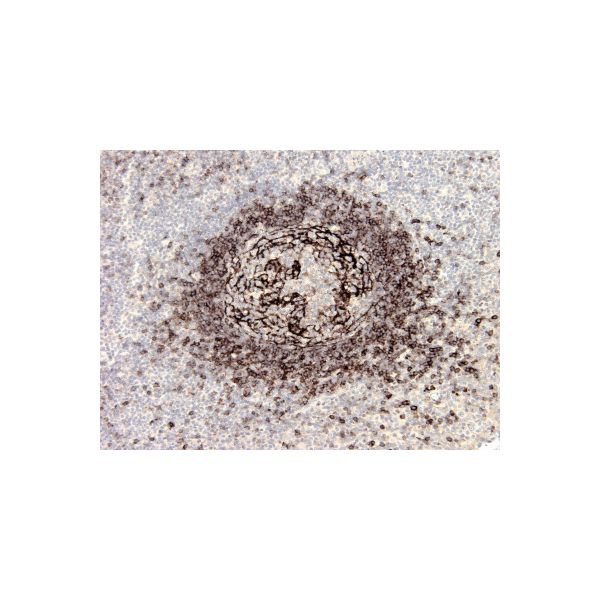Anti-CD23, mouse monoclonal, 1 ml, Species x-Reactivity: human, Applications: IHC
CD23
Cat#: BSH-2005-100 100ul, BSH-2005-1 1ml, BSH-2005-RTU 7ml
Clone: BS99
S/R: human
Application: IHC-P
Control tissue: Tonsil, appendix
The human leukocyte differentiation antigen CD23 (FCER2) is a key molecule for B-cell activation and growth. It is the low-affinity receptor for IgE. The truncated molecule can be secreted, then functioning as a potent mitogenic growth factor. It is expressed on most mature, conventional B cells (but not on peritoneal CD5+ B cells), and can also be found on the surface of T cells, macrophages, platelets and EBV transformed B lymphoblasts. Expression of CD23 has been detected in neoplastic cells from cases of B cell chronic Lymphocytic leukemia. CD23 is expressed by B cells in the follicular mantle zone but not by proliferating germinal centre cells. CD23 is also expressed by eosinophils. CD23 is distinct from the high affinity IgE receptors found on basophils and mast cells, which mediate allergic reactions. The low affinity receptors are thought to play a role in isotype specific immunoregulation. The regulation of CD23 surface expression appears to be integral with the complex IgE system, which involves interactions of cells, cytokines, antibodies and regulatory factors.
 |
 |
|
Tonsil (A & B) has stained with CD23 (Clone: BS99) optibody using 1:200 dilution and pH9 tris-EDTA pretreatment. B |
|
| Price | 2.970,00 RON (preturile sunt fara TVA) | ||||
|---|---|---|---|---|---|
| Description |
CD23 Cat#: BSH-2005-100 100ul, BSH-2005-1 1ml, BSH-2005-RTU 7ml The human leukocyte differentiation antigen CD23 (FCER2) is a key molecule for B-cell activation and growth. It is the low-affinity receptor for IgE. The truncated molecule can be secreted, then functioning as a potent mitogenic growth factor. It is expressed on most mature, conventional B cells (but not on peritoneal CD5+ B cells), and can also be found on the surface of T cells, macrophages, platelets and EBV transformed B lymphoblasts. Expression of CD23 has been detected in neoplastic cells from cases of B cell chronic Lymphocytic leukemia. CD23 is expressed by B cells in the follicular mantle zone but not by proliferating germinal centre cells. CD23 is also expressed by eosinophils. CD23 is distinct from the high affinity IgE receptors found on basophils and mast cells, which mediate allergic reactions. The low affinity receptors are thought to play a role in isotype specific immunoregulation. The regulation of CD23 surface expression appears to be integral with the complex IgE system, which involves interactions of cells, cytokines, antibodies and regulatory factors.
|
||||

 English
English




